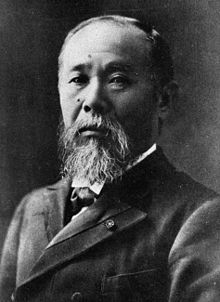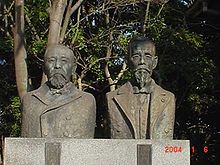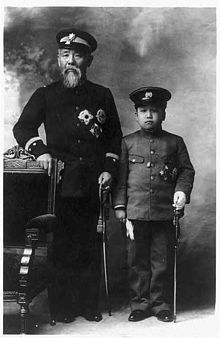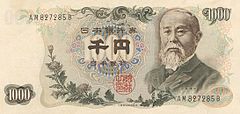- Itō Hirobumi
-
In this Japanese name, the family name is "Itō".
Itō Hirobumi
伊藤 博文
1st Prime Minister of Japan In office
19 October 1900 – 10 May 1901Monarch Meiji Preceded by Yamagata Aritomo Succeeded by Saionji Kinmochi (Acting) In office
12 January 1898 – 30 June 1898Monarch Meiji Preceded by Matsukata Masayoshi Succeeded by Ōkuma Shigenobu In office
8 August 1892 – 31 August 1896Monarch Meiji Preceded by Matsukata Masayoshi Succeeded by Kuroda Kiyotaka (Acting) In office
22 December 1885 – 30 April 1888Monarch Meiji Preceded by Position established Succeeded by Kuroda Kiyotaka Resident General of Korea In office
21 December 1905 – 14 June 1909Monarch Meiji Preceded by Position established Succeeded by Sone Arasuke Personal details Born 16 October 1841
Tsukari, JapanDied 26 October 1909 (aged 68)
Harbin, ManchuriaPolitical party Friends of Constitutional Government (1900–1909) Other political
affiliationsIndependent (Before 1900) Spouse(s) Itō Umeko Alma mater University College London Signature 
Prince Itō Hirobumi, GCB[1] (伊藤 博文, 16 October 1841 – 26 October 1909, also called Hirofumi/Hakubun and Shunsuke in his youth) was a samurai of Chōshū domain, Japanese statesman, four time Prime Minister of Japan (the 1st, 5th, 7th and 10th), genrō and Resident-General of Korea. Itō was assassinated by An Jung-geun, a Korean nationalist who was against the annexation of Korea by the Japanese Empire.[2] The politician, intellectual, and author Suematsu Kenchō was Itō’s son-in-law, having married his second daughter, Ikuko.
Contents
Life
Early years
Itō was born as the son of Hayashi Juzo. He was originally named Hayashi Risuke. His father Hayashi Juzo was the adopted son of Mizui Buhei who was an adopted son of Itō Yaemon's family, a lower class samurai from Hagi, Chōshū domain (present-day Yamaguchi prefecture). Mizui Buhei was renamed to Itō Naoemon. Mizui Juzo took the name Itō Juzo, and Hayashi Risuke was renamed to Itō Shunsuke at first, then Itō Hirobumi. He was a student of Yoshida Shōin at the Shōka Sonjuku and later joined the Sonnō jōi movement (“to revere the Emperor and expel the barbarians”), together with Kido Takayoshi. Itō was chosen to be one of the Chōshū Five who studied at University College London in 1863, and the experience in Great Britain convinced him of the necessity of Japan adopting Western ways.
In 1864, Itō returned to Japan with fellow student Inoue Kaoru to attempt to warn the Chōshū clan against going to war with the foreign powers (the Bombardment of Shimonoseki) over the right of passage through the Straits of Shimonoseki. At that time, he met Ernest Satow for the first time, later a lifelong friend.
Political career
After the Meiji Restoration, Itō was appointed governor of Hyōgo Prefecture, junior councilor for Foreign Affairs, and sent to the United States in 1870 to study Western currency systems. Returning to Japan in 1871, he established Japan's taxation system. Later that year, he was sent on the Iwakura Mission around the world as vice-envoy extraordinary, during which he won the confidence of Ōkubo Toshimichi one of the three great nobles who led the Meiji Restoration.
In 1873, Itō was made a full councilor, Minister of Public Works, and in 1875 chairman of the first Assembly of Prefectural Governors. He participated in the Osaka Conference of 1875. After Ōkubo's assassination, he took over the post of Home Minister and secured a central position in the Meiji government. In 1881 he urged Ōkuma Shigenobu to resign, leaving himself in unchallenged control.
Itō went to Europe in 1882 to study the constitutions of those countries, spending nearly 18 months away from Japan. While working on a constitution for Japan, he also wrote the first Imperial Household Law and established the Japanese peerage system (kazoku) in 1884.
In 1885, he negotiated the Convention of Tientsin with Li Hongzhang, normalizing Japan's diplomatic relations with Qing Dynasty China.
As Prime Minister
In 1885, based on European ideas, Itō established a cabinet system of government, replacing the Daijō-kan as the decision-making state organization, and on December 22, 1885, he became the first prime minister of Japan.
On April 30, 1888, Itō resigned as prime minister, but headed the new Privy Council to maintain power behind-the-scenes. In 1889, he also became the first genro. The Meiji Constitution was promulgated in February 1889. He had added to it the references to the kokutai or "national polity" as the justification of the emperor's authority through his divine descent and the unbroken line of emperors, and the unique relationship between subject and sovereign.[3] This stemmed from his rejection of some European notions as unfit for Japan, as they stemmed from European constitutional practice and Christianity.[3]
He remained a powerful force while Kuroda Kiyotaka and Yamagata Aritomo, his political nemeses, were prime ministers.
 Statues of Mutsu Munemitsu (Right) and Itō Hirobumi (Left) at Shimonoseki
Statues of Mutsu Munemitsu (Right) and Itō Hirobumi (Left) at Shimonoseki
During Itō’s second term as prime minister (August 8, 1892 – August 31, 1896), he supported the First Sino-Japanese War and negotiated the Treaty of Shimonoseki in March 1895 with his ailing foreign minister Mutsu Munemitsu. In the Anglo-Japanese Treaty of Commerce and Navigation of 1894, he succeeded in removing some of the onerous unequal treaty clauses that had plagued Japanese foreign relations since the start of the Meiji period.
During Itō’s third term as prime minister (January 12 – June 30, 1898), he encountered problems with party politics. Both the Jiyūtō and the Shimpotō opposed his proposed new land taxes, and in retaliation, Itō dissolved the Diet and called for new elections. As a result, both parties merged into the Kenseitō, won a majority of the seats, and forced Itō to resign. This lesson taught Itō the need for a pro-government political party, so he organized the Rikken Seiyūkai in 1900. Itō's womanizing was a popular theme in editorial cartoons and in parodies by contemporary comedians, and was used by his political enemies in their campaign against him.
Itō returned to office as prime minister for a fourth term from October 19, 1900, to May 10, 1901, this time facing political opposition from the House of Peers. Weary of political back-stabbing, he resigned in 1901, but remained as head of the Privy Council as the premiership alternated between Saionji Kimmochi and Katsura Tarō. Itō received an honorary doctorate from Yale University around this time.
It was during his terms as Prime Minister that he invited Professor George Trumbull Ladd of Yale University to serve as a diplomatic adviser to promote mutual understanding between Japan and the United States. It was because of his series of lectures he delivered in Japan revolutionizing its educational methods, that he was the first foreigner to receive the Second Class honor (conferred by the Meiji Emperor in 1907) and the Third Class honor (conferred by The Meiji Emperor in 1899), Orders of the Rising Sun. He later wrote an interesting book on his personal experiences in Korea and with Resident-General Ito.[4][5][6] Following his assassination, half of Hirobumi's ashes were buried in a Tokyo Temple and a monument was erected to him.[5][7]
As Resident-General of Korea
In November 1905, following the Russo-Japanese War, the Korean government signed the Eulsa Treaty, making Korea a Japanese protectorate. After the Eulsa Treaty had been signed, Itō became the first Resident-General of Korea on December 21, 1905. He urged Emperor Gojong to abdicate in 1907 in favor of his son Emperor Sunjong and pushed through the Japan-Korea Annexation Treaty of 1907, giving Japan control over Korean internal affairs. However, Ito's position was nuanced. He was firmly against Korea falling into the hand of China and Russia, which would cause a grave threat to Japan's national security. However, he was actually against the annexation, instead advocating that Korea remain a protectorate. When the cabinet eventually voted to annex Korea, he insisted and obtained a delay, hoping that the decision of annexation could be reversed in the future.[8] His political nemesis, the politically influential Imperial Japanese Army, led by Yamagata Aritomo, whose main faction was advocating annexation forced Itō to resign on June 14, 1909. His assassination is believed to have accelerated the path to the Japan-Korea Annexation Treaty.[9]
Itō proclaimed[when?] that if East Asia would not co-operate together like brothers, all would be absorbed into Western countries. Gojong and the Joseon government believing in these claims, agreed to help the Japanese military. However, the opinion of Joseon soon turned against Japan as many Japanese actions were considered to be too brutal and barbaric including confiscation of lands and drafting civilians for forced labor, even executing those that resisted.[10] Ironically his killer An Jung-geun strongly believed in a union of the three great countries in East Asia, China, Korea, and Japan in order to counter and fight off the "White Peril", being the European countries engaged in colonialism, restoring peace to East Asia.
Using considerable political and foreign policy skills, and aided by strong Japanese military, Ito laid the foundation for Japan's colonization of Korea and expansion into Manchuria, China and Russia.[citation needed]
Assassination
Itō arrived at the Harbin Railway Station on October 26, 1909 for a meeting with Vladimir Kokovtsov, a Russian representative in Manchuria. When he arrived and proceeded to meet his Russian colleague, An Jung-geun, a Korean nationalist[9] and independence activist,[11][12] fired six shots at him. Three of those shots hit Itō in the chest and he died shortly thereafter.
Legacy
A portrait of Itō Hirobumi was on the 1,000 yen note of Japan from 1963 until a new series was issued in 1984. His former house is preserved as a museum near the Shoin Jinja, in Hagi city, Yamaguchi prefecture. However, the actual structure was Itō’s second home, formerly located in Shinagawa, Tokyo.
The publishing company Hakubunkan was named after Itō, based on an alternate pronunciation of his given name.
Evaluation in modern Korea
According to Sunjong Sillok, Gojong said on October 28, 1909 that Itō Hirobumi made great efforts to develop civilization. However, it should be noted that Gojong sillok and Sujong sillok are regarded as "unreliable documents" by National Institute of Korean History, given that the two sillok are not designated as National Treasures of South Korea and UNESCO's World Heritage unlike other sillok due to Japanese influence exerted on them. They consider these last two documents are regarded as a falsification of history.[13]
The 1979 North Korean film, An Jung-gun Shoots Ito Hirobumi, is an account of Hirobumi's assassination from the North Korean perspective.
1973 South Korean film Femme Fatale:Bae Jeong-ja is life of Ito's apdoted daughter Bae Jung-ja (1850-1950)
Genealogy
- Hayashi family
∴Hayasi Awajinokami Michioki ┃ ┣━━━━┳━━━━┳━━━━━━━━━━┳━━━━━┳━━━━━━┳━━━━┳━━━━━┓ ┃ ┃ ┃Hayasi Magoemon ┃ ┃ ┃ ┃ ┃ Michimoto Michiyo Michisige Michiyoshi Michisada Michikata Michinaga Michisue ┃ ┃ ┃Hayasi Magosaburō Nobukatsu ┃ ┃ ┃Hayasi Magoemon Nobuyoshi ┃ ┏━━━━━━━━━━╋━━━━━┳━━━━┓ ┃Hayasi Magoemon ┃ ┃ ┃ Nobuaki Sakuzaemon Sojyurō Matazaemon ┃ ┃ ┃ ┃ ┃Hayasi Hanroku ┃ Nobuhisa Genzō ┃ ┃ ┣━━━━━┓ ┃ ┃ ┃ ┃ Sōzaemon Heijihyōe Yoichiemon ┃ ┃ ┏━━━━━┻━━━┓ ┏━━━┫ ┃Hayasi Hanroku ┃ ┃ ┃ Rihachirō Riemon Masuzō Sukezaemon ┃adopted son of Hayasi Rihachirō ┏━━━┳━━━━━━━━━━━━┫ ┃Itō ┃Hayasi Shinbei's wife ┃Morita Naoyoshi's wife Jyuzō woman woman ┃ ┃ ┃Itō Hirobumi ┃ ┏━━━━╋━━━━━┳━━━━━┳━━━┓ ┃Itō ┃Kida ┃Itō ┃ ┃ Hirokuni Humiyoshi Shinichi woman woman ┃ ┣━━━━┳━━━━━┳━━━━━━━┳━━━┳━━━━━┳━━━━┳━━━━━┳━━━━━┳━━━━━┳━━━━━┳━━━┳━━━┓ ┃Itō ┃Shimizu ┃Itō ┃Itō ┃Itō ┃Itō ┃Itō ┃Itō ┃Itō ┃Itō ┃ ┃ ┃ Hirotada Hiroharu Hiromichi Hiroya Hirotada Hiroomi Hironori Hirotsune Hirotaka Hirohide woman woman woman ┃ ┣━━━━┳━━━┳━━┳━━━━┳━━┓ ┃Itō ┃ ┃ ┃ ┃ ┃ Hiromasa woman woman woman woman woman ┃ ┣━━━━┓ ┃Itō ┃ Tomoaki woman
- Itō family
∴ Itō Yaemon ┃ Itō Naoemon (Mizui Buhei)Yaemon's adopted son ┃ Itō Jyuzō (Hayashi Jyuzo)Naoemon's adopted son ┃ Itō Hirobumi (Hayashi Risuke)
See also
- Japanese students in Britain
Notes
- ^ London Gazette
- ^ Dudden, Alexis (2005). Japan's Colonization of Korea: Discourse and Power. University of Hawaii Press. ISBN 0-82482-829-1.
- ^ a b W. G. Beasley,The Rise of Modern Japan, p 79-80 ISBN 0-312-04077-6
- ^ Topics of the Week: "George Trumbull Ladd," New York Times. February 22, 1908.
- ^ a b "Business: Japanese Strip," Time Magazine. May 8, 1939.
- ^ "American Honored by the Japanese," The New York Times. October 22, 1899.
- ^ "Great Head Temple Sôjiji". 2007. http://www.terebess.hu/zen/sojiji/szodzsi.html. Retrieved 2009-07-29.
- ^ Umino, Fukuju (2004). Hirobumi Ito and Korean Annexation (Ito hirobumi to kankoku heigou). Aoki Shoten. ISBN 978-4250204142.
- ^ a b Keene, Donald (2002). Emperor of Japan: Meiji and His World, 1852–1912. Columbia University Press. pp. 662–667. ISBN 0-231-12340-X.
- ^ Lee Jeong-sik (이정식), emeritus professor at University of Pennsylvania (May 2001). (긴급대특집) 일본 역사교과서 왜곡파문. Sindonga. http://www.donga.com/docs/magazine/new_donga/200105/nd2001050030.html.
- ^ "What Defines a Hero?". Japan Society. http://aboutjapan.japansociety.org/content.cfm/hero. Retrieved 2008-01-29.
- ^ An, Jung-geun, Naver encyclopedia
- ^ Yu Seok-jae (유석재) (2007-01-14). "고종·순종실록의 '찜찜한' 인터넷 공개". The Chosun Ilbo. http://news.chosun.com/site/data/html_dir/2007/01/14/2007011400715.html.
References
- Nish, Ian. (1998) The Iwakura Mission to America and Europe: A New Assessment. Richmond, Surrey: Japan Library. 10-ISBN 1873410840/13-ISBN 9781873410844; 10-ISBN 9780415471794/13-ISBN 0415471796; OCLC 40410662
Further reading
- Hamada Kengi (1936). Prince Ito. Tokyo: Sanseido Co.
- Johnston, John T.M. (1917). World patriots. New York: World Patriots Co.
- Kusunoki Sei'ichirō (1991). Nihon shi omoshiro suiri: Nazo no satsujin jiken wo oe. Tokyo: Futami bunko.
- Ladd, George T. (1908). In Korea with Marquis Ito
- Nakamura Kaju (1910). Prince Ito, the man and the statesman, a brief history of his life. New York: Japanese-American commercial weekly and Anraku Pub. Co.
- Palmer, Frederick (1910). Marquis Ito: the great man of Japan. n.p.
External links
- Biographical material at the Notable Names Database.
- About Japan: A Teacher's Resource Ideas about how to teach about Ito Hirobumi in a K-12 classroom
Political offices New office Prime Minister of Japan
1885–1888Succeeded by
Kuroda KiyotakaPreceded by
Matsukata MasayoshiPrime Minister of Japan
1892–1896Succeeded by
Kuroda Kiyotaka
ActingPrime Minister of Japan
1898Succeeded by
Ōkuma ShigenobuPreceded by
Yamagata AritomoPrime Minister of Japan
1900–1901Succeeded by
Saionji Kinmochi
ActingNew office Resident General of Korea
1905–1909Succeeded by
Sone ArasukePrime Ministers of Japan (List) 
H. Itō · Kuroda · Sanjō · Yamagata · Matsukata · H. Itō · Kuroda · Matsukata · H. Itō · Ōkuma · Yamagata · H. Itō · Saionji · Katsura · Saionji · Katsura · Saionji · Katsura · Yamamoto · Ōkuma · Terauchi · Hara · Uchida · Takahashi · To. Katō · Uchida · Yamamoto · Kiyoura · Ta. Katō · Wakatsuki · G. Tanaka · Hamaguchi · Shidehara · Hamaguchi · Wakatsuki · Inukai · Takahashi · Saitō · Okada · Gotō · Okada · Hirota · Hayashi · Konoe · Hiranuma · N. Abe · Yonai · Konoe · Tōjō · Koiso · K. Suzuki · Higashikuni · Shidehara · Yoshida · Katayama · Ashida · Yoshida · I. Hatoyama · Ishibashi · Kishi · Ikeda · Satō · K. Tanaka · Miki · T. Fukuda · Ōhira · M. Itō · Z. Suzuki · Nakasone · Takeshita · Uno · Kaifu · Miyazawa · Hosokawa · Hata · Murayama · Hashimoto · Obuchi · Aoki · Mori · Koizumi · S. Abe · Y. Fukuda · Aso · Y. Hatoyama · Kan · Noda
 Italics denote acting Prime Ministers
Italics denote acting Prime MinistersForeign Ministers of Japan Inoue · Itō · Ōkuma (1st) · Aoki (1st) · Enomoto · Mutsu · Saionji (1st) · Ōkuma (2nd) · Nishi · Ōkuma (3rd) · Aoki (2nd) · Katō (1st) · Sone · Komura (1st) · Katō (2nd) · Saionji (2nd) · T. Hayashi · Terauchi (1st) · Komura (2nd) · Uchida (1st) · Katsura · Katō (3rd) · Makino · Katō (4th) · Ōkuma (4th) · Ishii · Terauchi (2nd) · Motono · Gotō · Uchida (2nd) · Yamamoto · Ijuin · Matsui · Shidehara (1st) · G. Tanaka · Shidehara (2nd) · Inukai · Yoshizawa · Uchida (4th) · Saitō · Hiroda · Arita · S. Hayashi · N. Satō · Hirota · Ugaki · Arita · N. Abe · K. Nomura · Arita · Matsuoka · Toyoda · S. Tōgō (1st) · Tōjō · Tani · Shigemitsu (1st) · S. Tōgō (2nd) · Shigemitsu (2nd) · K. Suzuki · Yoshida (1st) · Ashida · Yoshida (2nd) · Shigemitsu (3rd) · Kishi · Fujiyama · Kosaka · Ōhira · Shiina · Miki · Aichi · Fukuda · Ōhira · Kimura · Miyazawa · Kosaka · Hatoyama · Sonoda · Okita · M. Ito · Sonoda · Sakurauchi · S. Abe · Kuranari · Uno · Mitsuzuka · Nakayama · Watanabe · Mutō · Hata · Kakizawa · Kono (1st) · Ikeda · Obuchi · Kōmura (1st) · Kono (2nd) · M. Tanaka · Koizumi · Kawaguchi · Machimura (1st) · Aso · Machimura (2nd) · Kōmura (2nd) · Nakasone · Okada · Maehara · Matsumoto · Genba
Categories:- 1841 births
- 1909 crimes
- 1909 assassinations
- 1909 deaths
- Deaths by firearm in China
- Japanese people murdered abroad
- Members of the House of Peers (Japan)
- Assassinated Japanese politicians
- Prime Ministers of Japan
- Japanese Residents-General of Korea
- Japanese diplomats
- Meiji Restoration
- Mōri retainers
- Kazoku
- Samurai
- Japanese expatriates in the United Kingdom
- People associated with University College London
- Alumni of University College London
- People from Chōshū domain
- People from Yamaguchi Prefecture
- People in Meiji period Japan
- People murdered in China
- People of the First Sino-Japanese War
- Japanese people of the Russo-Japanese War
- Rikken Seiyūkai politicians
- Honorary Knights Grand Cross of the Order of the Bath
- Knights of the Order of the Most Holy Annunciation
- Grand Croix of the Légion d'honneur
- Grand Cordons of the Order of Leopold (Belgium)
- Recipients of the Order of the Chrysanthemum
- Recipients of the Order of the Rising Sun
- Commanders First Class of the Order of Vasa
Wikimedia Foundation. 2010.



